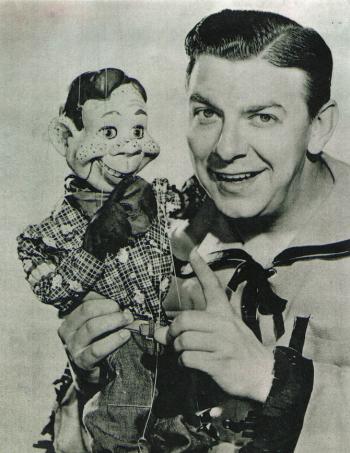The Best of Television
There's Gold To Be Seen in the Peabody Archives

Howdy Doody and Buffalo Bob Smith
When it comes to highlighting the finest in electronic broadcast media, including news programs, radio, documentaries and television and cable programs, the prestigious George Foster Peabody Awards are the best you can get. What many people may not know, however, is that the Peabody Awards are based here in Athens at the University of Georgia and that its rich and extensive Walter J. Brown Media Archive and Peabody Awards Collection is open to the non-student public. Considering the broadcast archive is the largest repository of its kind in the Southeast, that is impressive, and the museum should be a frequent destination for any thoughtful, pop culture savvy mediahead.
Beginning in September, the Peabody Awards and the Peabody Awards Collection will start a new thematic series highlighting many of the extraordinary productions given special notice over the decades since the awards were first established in 1940 for radio and 1948 for television.
On September 10, the program kicks off with America in the 1940s: More than the Home Front, a showcase of newsreels, footage from classic kids' shows like the iconic “Howdy Doody” and the lesser-known program “Mr. I. Magination,” an early episode of “Meet the Press” from 1948 and other programs. There will also be some scenes from the obscure early NBC courtroom drama “The Black Robe,” which recreated night court cases with actors but occasionally featured real defendants as well. Fans and scholars of law/crime dramas and reality television may find this one fascinating.
The intent of the one-night showcase is to give a sense of what Americans were watching in their homes while World War II raged in Europe and the Pacific. Television was just getting started during that decade, so this presentation should make for a fascinating evening. The event will start at 6:30 p.m. with refreshments and then the screenings at 7 p.m., with a discussion held afterward.
A few weeks later, on September 24, the award-winning HBO made-for-TV movie The Tuskegee Airmen (1995), starring Laurence Fishburne, Andre Braugher and Cuba Gooding, Jr., will be screened. The movie focuses on the first African American World War II fighter pilots, who flew through the skies of Europe on their missions engaging the German Luftwaffe. The more recent aerial combat movie Red Tails is flashier, but this is the movie to see for anyone with an interest in this fascinating story about men who were the victims of racism yet who proudly fought for their country to help eradicate an enemy whose political policies and philosophical ideas were founded on racial intolerance.
The full schedule is still not out, but each month will focus on some of the best productions that helped define their decades. October will feature some culturally important gems ion two nights of showings from the 1950s, that early Golden Era of television, including journalist Edward R. Murrow's groundbreaking news program “See it Now,” scenes from the legendary variety program “The Ed Sullivan Show” and the sitcom “Mr. Peepers,” which focused on the day-to-day ups and comedic downs of a junior high science teacher played by Wally Cox. No doubt, other media treasures will be shown. The real meat of this night's program should be “See it Now,” a program that was an extension of Murrow's earlier radio program “Hear it Now.” Television news magazine shows like this—e.g. “60 Minutes,” “Nightline,” “Dateline” and others—are common nowadays, but this show laid the groundwork, and Murrow is still viewed today as a legend in his field for his responsible, real journalism, something that seems all-too rare in this age of corporate opinions masked as objective reporting. Murrow's courageous scrutiny, suspicion and criticism of Senator Joseph McCarthy's anti-Communist Red Scare trials was chronicled in George Clooney's 1995 movie Good Night, and Good Luck, with actor David Strathairn playing Murrow.
On the second night of the 1950s showcase, the influential live “Playhouse 90” television drama Requiem for a Heavyweight will be screened. Written by the legendary Rod Serling, it stars Jack Palance as a physically and psychologically scarred down-and-almost-out boxer. The magnificent Kim Hunter also stars in this must-see program. Serling, who later went on to create “The Twilight Zone” and “Night Gallery” series long considered this program the best writing of his esteemed career.
November will focus on the 1960s, and the series progresses through each decade up to the present until it finishes in spring 2014. All of the screenings are free and will be shown in the theater located in UGA’s new Richard B. Russell Special Collections Libraries, 300 S. Hull St., with parking in the Hull Street deck south of Special Collections. The full schedule of showings will be posted at www.peabodyawards.com when ready.
Keywords
More by Derek Hill
-

Birdman or (The Unexpected Virtue of Ignorance)
Movie Review
-

20,000 Days on Earth
Movie Review
-

St. Vincent
Movie Review









comments